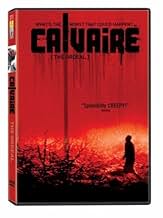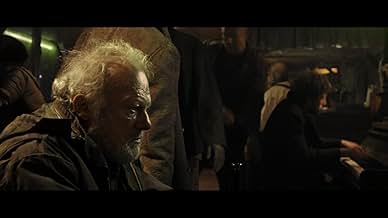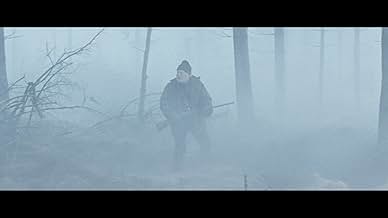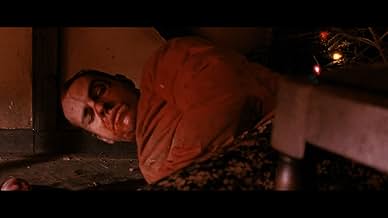CALIFICACIÓN DE IMDb
6.1/10
15 k
TU CALIFICACIÓN
Marc, un artista ambulante, vuelve a casa por Navidad cuando su furgoneta se detiene en medio de una ciudad cutre con unos habitantes extraños.Marc, un artista ambulante, vuelve a casa por Navidad cuando su furgoneta se detiene en medio de una ciudad cutre con unos habitantes extraños.Marc, un artista ambulante, vuelve a casa por Navidad cuando su furgoneta se detiene en medio de una ciudad cutre con unos habitantes extraños.
- Dirección
- Guionistas
- Elenco
- Premios
- 4 premios ganados y 3 nominaciones en total
Alfred David
- Roland
- (as Alfred David-Pingouin)
- Dirección
- Guionistas
- Todo el elenco y el equipo
- Producción, taquilla y más en IMDbPro
Opiniones destacadas
Fabrice Du Weiz's thriller mines "The Texas Chainsaw Massacre", "Deliverance" and "Straw Dogs", Still, it is unique enough and original enough in its cinematic eccentricities to be noteworthy.
A travelling showman (Laurent Lucas) finds himself in hostile territory when his van breaks down. A local jack-of-all-trades (Jackie Berroyer) helps him out, but is soon helping himself to Lucas's van, mind and body.
The film takes interesting, perverted turns and dishes the atmosphere thick. A fog-shrouded chase through the woods is almost surreal, and a fantastic dance sequence with hillbilly-like weirdos works a twisted treat and foreshadows a surplus of gloom and doom.
The violence is not plentiful, but the sense of threat is always present. Benoit Debie, who photographed Gasper Noe's IRREVERSIBLE, creates memorable, haunting images and makes expert use of the terrific locales.
A solid, oddball shocker, but overlong at times.
A travelling showman (Laurent Lucas) finds himself in hostile territory when his van breaks down. A local jack-of-all-trades (Jackie Berroyer) helps him out, but is soon helping himself to Lucas's van, mind and body.
The film takes interesting, perverted turns and dishes the atmosphere thick. A fog-shrouded chase through the woods is almost surreal, and a fantastic dance sequence with hillbilly-like weirdos works a twisted treat and foreshadows a surplus of gloom and doom.
The violence is not plentiful, but the sense of threat is always present. Benoit Debie, who photographed Gasper Noe's IRREVERSIBLE, creates memorable, haunting images and makes expert use of the terrific locales.
A solid, oddball shocker, but overlong at times.
Saw this film as part of the Gala Opening for the Cinemuerte Horror Film Festival in Vancouver recently. I kinda knew what to expect from reading a description of the film before going in, but it still was quite the cinematic experience.
Suffice it to say, I'd be hard-pressed to recommend this film to anyone in my particular circle of friends (well, maybe a few), but the film had me mesmerized, and since I do enjoy dark cinema, I'd have to say I certainly enjoyed it for what it was. There were images and scenes in the film that stayed with me after, and it certainly had a noticeable effect on the audience attending. Some liked it. Some hated it. Some didn't enjoy the "pig squealing"...like one girl in the audience noted after the film had ended. (you'll understand more towards the latter-half of the film) Elements of "Deliverance", "Southern Comfort", "Texas Chainsaw Massacre" are all here, with more dark humour involved. Dark, very dark humour.
The cinematography was incredible. You've never seen the wilderness shot to look so menacing, yet maintaining a strange, dread-filled beauty. And yet it also seems endless, as if civilization is nowhere near where the events in the film take place. I unconsciously wrapped my arms around myself during the movie, from both the tension in the film, and from feeling I myself was out there in the chill of the woods.
I won't go into the plot-line, since a few others already have, but this film gives good credence to making sure that if you go driving in the country, your engine has had a recent tune-up, and you've got plenty of gas in the tank. AND to make sure you're cautious about the seeming kindness of strangers...
Suffice it to say, I'd be hard-pressed to recommend this film to anyone in my particular circle of friends (well, maybe a few), but the film had me mesmerized, and since I do enjoy dark cinema, I'd have to say I certainly enjoyed it for what it was. There were images and scenes in the film that stayed with me after, and it certainly had a noticeable effect on the audience attending. Some liked it. Some hated it. Some didn't enjoy the "pig squealing"...like one girl in the audience noted after the film had ended. (you'll understand more towards the latter-half of the film) Elements of "Deliverance", "Southern Comfort", "Texas Chainsaw Massacre" are all here, with more dark humour involved. Dark, very dark humour.
The cinematography was incredible. You've never seen the wilderness shot to look so menacing, yet maintaining a strange, dread-filled beauty. And yet it also seems endless, as if civilization is nowhere near where the events in the film take place. I unconsciously wrapped my arms around myself during the movie, from both the tension in the film, and from feeling I myself was out there in the chill of the woods.
I won't go into the plot-line, since a few others already have, but this film gives good credence to making sure that if you go driving in the country, your engine has had a recent tune-up, and you've got plenty of gas in the tank. AND to make sure you're cautious about the seeming kindness of strangers...
The subject is not new: the you-take-your-life-in-your -hands -when -you-get-into -that-inn trick was the subject of Claude Autant-Lara's "L'Auberge Rouge" (1951)and of Hitchcock's "psycho" .One can also notice borrowings from Schoedsack/Pichel's "the most dangerous game" (1932) ,from "Texas chain saw massacre " ,from François Ozon's "Les Amants Criminels"(1996) .The atmosphere even recalls sometimes that of the director's compatriot André Delvaux's "Un Soir Un train" (1968).But the main influence is a French movie: "Barracuda " by Philippe Haïm starring Guillaume Canet and Jean Rochefort;Marc and Bartel strongly recall their characters.
Let's forget the hackneyed quicksands trick,which could not happen ,if the writers knew about Archimedes's theorem.All that remains is really spooky.The first part succeeds in building a tension ,without any special effect.The Christmas party,when the singer performs in front of a bunch of old ladies in an old people's home already leaves the viewer ill at ease.In the following sequences ,fear grows and never leaves you.Even the story of the dwarfs (did you notice the children dressed as little red riding hoods in the woods?) and Mark's song seem lugubrious,sinister.
Except for the old ladies and the nurse who takes care of them (played by an ex-porno star Brigitte Lahaie) ,and one or two peasant women on the farm,this is a male bestial atmosphere.Marc's cries look like animal screams .
Not for the squeamish.
Let's forget the hackneyed quicksands trick,which could not happen ,if the writers knew about Archimedes's theorem.All that remains is really spooky.The first part succeeds in building a tension ,without any special effect.The Christmas party,when the singer performs in front of a bunch of old ladies in an old people's home already leaves the viewer ill at ease.In the following sequences ,fear grows and never leaves you.Even the story of the dwarfs (did you notice the children dressed as little red riding hoods in the woods?) and Mark's song seem lugubrious,sinister.
Except for the old ladies and the nurse who takes care of them (played by an ex-porno star Brigitte Lahaie) ,and one or two peasant women on the farm,this is a male bestial atmosphere.Marc's cries look like animal screams .
Not for the squeamish.
I wish to start saying, that this movie is definitely not enjoyable at all. By the means of having a great fun time at the movie-theatre.
So if you are mostly to Hollywood-Popcorn-Horror-Flics and that's exactly what you expect of a good movie, do yourself a favor and don't watch CALVAIRE.
If you like European Art-house Cinema and are also devoted to real rough and downbeating horror movies, you should have a closer look at this interestingly done work of Fabrice Du Welz.
The young director puts the viewer always in the middle of what is shown on the screen. The beautiful photographed frames are supported through the high grained film material. It nearly looks like a dokumentary, but without the handhold camera style. No bright colours have been used, the colours even look washed out, slightly fading into grey. So the look is very authentic. The Settings are all natural. There is no artificial studio-stage touch in this movie. No additional lightning seems to be added. This style helps the movie to draw the audience perfect into it. Shot on an aspect ratio of 2.35 : 1, this movie is a real cineatic feast when taking part in a movie theatre presentation. Its frames stand for themselves. The power of the pictures (like paintings) speak a more clearly language than every average dialogue in a Hollywood production does. This is cineastic story telling at its best. I also liked the extremely slow pasted development of the story.
The movie's start-off could be made by FRANCOIS TRUFFAUT. Even the protagonist, Marc Stevens (played by LAURENT LUCAS) reminded me a bit of JEAN PIERRE LEAUD (he portraited the character of Antoine Doinel in 4 of Truffaut's films). He performs a chansons singer, who is about to travel through the country for his next concert to give. Unfortunately his traveling van stops in the middle of nowhere. Not enough to be stucked deep in an unknown forest it is - of course - raining cats and dogs. Guided by a young man, who is searching the forest for his missing dog, Stevens reaches an auberge (motel) by foot. The owner, Mr. Bartel lives all alone in there. The auberge has been closed a long time ago for the public. But the kindly behaving old man has preserved the rooms as they where when guests used to be around. Bartel is a man who seems to earn his living with farming. No other houses are build near his estate. Stevens is offered to stay for the night and Bartel promises to get and repair his broken van the next morning. During the dinner Bartel tells Stevens that he was left by his wife and we feel, that he's still suffering from that loss. He seems to be most happy about that his guest is an artist, acclaiming he was an artist too. Not a singer but a comedian, who even won a price for his humor. By the way, his gone wife had been a passionded artist too, so he tells. After a short performance of Stevens, Bartel begins crying. Bartel is fascinated by the singers passion to his art and becomes very sad due to his lost past in which he obviously still lives (imaginary).
Stevens goes to bed after this conversation, Thinking, he will be able to continue his journey the next day. But his unexpected rest at the auberge will be unwillingly prolonged for a much longer time than he could imagine at that moment.
What happens next is a slow pasted tour de force of pain, agony, fear and hatred in the strangest way ever filmed for the big screen. Including the disturbing sickness of Bartel's mind. But he is not the only weird guy around this area. The most over-the-top portraited hillbillies ever shown up in a movie will appear in the near future to enlight the audience with laughs and - followed up - with the helpless fear of "what will there be next?". Have a seat, take a roller-coaster ride with a movie which leaves the shocks of THE Texas CHAINSAW MASSACRE and STRAW DOGS easily behind. I understand this one as a very, very black comedy which is "enjoyable" for open minded people with a cineastic interest.
There are some things in this movie which may let one think, this is an analogy to the passion of Jesus Christ. Some symbols cannot be overseen. The conversation about passion for the things you do by heart are significant. At the end, all things become clear (I don't want to spoil it here) and the audience is left alone with it. A very long end-credit sequence follows. Like in the movie SEUL CONTRE TOUS (I STAND ALONE/ MENSCHENFEIND) from director GASPAR NOÉ, an open end is presented. In Noé's movie a road is shown, leading to nowhere (or to an unknown future), while in Du Welz' movie we are left alone in a wide opened cold and foggy snow frozen forest area. We listen to the sounding wind. It blows and blows - not willing to end its cruel howling. No music, just the never ending isolation.
If you see this "wonderful" movie you'll remember this howling a long time.
8 out of 10
P.S. please excuse possible spelling mistakes
So if you are mostly to Hollywood-Popcorn-Horror-Flics and that's exactly what you expect of a good movie, do yourself a favor and don't watch CALVAIRE.
If you like European Art-house Cinema and are also devoted to real rough and downbeating horror movies, you should have a closer look at this interestingly done work of Fabrice Du Welz.
The young director puts the viewer always in the middle of what is shown on the screen. The beautiful photographed frames are supported through the high grained film material. It nearly looks like a dokumentary, but without the handhold camera style. No bright colours have been used, the colours even look washed out, slightly fading into grey. So the look is very authentic. The Settings are all natural. There is no artificial studio-stage touch in this movie. No additional lightning seems to be added. This style helps the movie to draw the audience perfect into it. Shot on an aspect ratio of 2.35 : 1, this movie is a real cineatic feast when taking part in a movie theatre presentation. Its frames stand for themselves. The power of the pictures (like paintings) speak a more clearly language than every average dialogue in a Hollywood production does. This is cineastic story telling at its best. I also liked the extremely slow pasted development of the story.
The movie's start-off could be made by FRANCOIS TRUFFAUT. Even the protagonist, Marc Stevens (played by LAURENT LUCAS) reminded me a bit of JEAN PIERRE LEAUD (he portraited the character of Antoine Doinel in 4 of Truffaut's films). He performs a chansons singer, who is about to travel through the country for his next concert to give. Unfortunately his traveling van stops in the middle of nowhere. Not enough to be stucked deep in an unknown forest it is - of course - raining cats and dogs. Guided by a young man, who is searching the forest for his missing dog, Stevens reaches an auberge (motel) by foot. The owner, Mr. Bartel lives all alone in there. The auberge has been closed a long time ago for the public. But the kindly behaving old man has preserved the rooms as they where when guests used to be around. Bartel is a man who seems to earn his living with farming. No other houses are build near his estate. Stevens is offered to stay for the night and Bartel promises to get and repair his broken van the next morning. During the dinner Bartel tells Stevens that he was left by his wife and we feel, that he's still suffering from that loss. He seems to be most happy about that his guest is an artist, acclaiming he was an artist too. Not a singer but a comedian, who even won a price for his humor. By the way, his gone wife had been a passionded artist too, so he tells. After a short performance of Stevens, Bartel begins crying. Bartel is fascinated by the singers passion to his art and becomes very sad due to his lost past in which he obviously still lives (imaginary).
Stevens goes to bed after this conversation, Thinking, he will be able to continue his journey the next day. But his unexpected rest at the auberge will be unwillingly prolonged for a much longer time than he could imagine at that moment.
What happens next is a slow pasted tour de force of pain, agony, fear and hatred in the strangest way ever filmed for the big screen. Including the disturbing sickness of Bartel's mind. But he is not the only weird guy around this area. The most over-the-top portraited hillbillies ever shown up in a movie will appear in the near future to enlight the audience with laughs and - followed up - with the helpless fear of "what will there be next?". Have a seat, take a roller-coaster ride with a movie which leaves the shocks of THE Texas CHAINSAW MASSACRE and STRAW DOGS easily behind. I understand this one as a very, very black comedy which is "enjoyable" for open minded people with a cineastic interest.
There are some things in this movie which may let one think, this is an analogy to the passion of Jesus Christ. Some symbols cannot be overseen. The conversation about passion for the things you do by heart are significant. At the end, all things become clear (I don't want to spoil it here) and the audience is left alone with it. A very long end-credit sequence follows. Like in the movie SEUL CONTRE TOUS (I STAND ALONE/ MENSCHENFEIND) from director GASPAR NOÉ, an open end is presented. In Noé's movie a road is shown, leading to nowhere (or to an unknown future), while in Du Welz' movie we are left alone in a wide opened cold and foggy snow frozen forest area. We listen to the sounding wind. It blows and blows - not willing to end its cruel howling. No music, just the never ending isolation.
If you see this "wonderful" movie you'll remember this howling a long time.
8 out of 10
P.S. please excuse possible spelling mistakes
This was the best film I saw at London's 2004 Frightfest, much better than the over-hyped but ultimately disappointing Haute Tension, the other French language horror entry.
Superficially this is the Belgian take on the "crazed hillbilly" sub-genre of Last House on the Left or Deliverance, but in it's mixture of horror and surreal humor this is closer to something like Roman Polanski's The Tenant. The portrait of an isolated society who lives without women is taken to its logical and often shocking extremes. There is a scene at the local bar which must rank among the strangest and most memorable set pieces in recent years. The film is very atmospheric and the cinematography is stunning. You can almost feel the chill of the winter forest it takes place in.
Hopefully Calvaire (it's English title was The Ordeal when I saw it) will get a proper release in English speaking territories, though I can see that this is a much more difficult sell than the derivative calling card exercise that was Haute Tension.
Superficially this is the Belgian take on the "crazed hillbilly" sub-genre of Last House on the Left or Deliverance, but in it's mixture of horror and surreal humor this is closer to something like Roman Polanski's The Tenant. The portrait of an isolated society who lives without women is taken to its logical and often shocking extremes. There is a scene at the local bar which must rank among the strangest and most memorable set pieces in recent years. The film is very atmospheric and the cinematography is stunning. You can almost feel the chill of the winter forest it takes place in.
Hopefully Calvaire (it's English title was The Ordeal when I saw it) will get a proper release in English speaking territories, though I can see that this is a much more difficult sell than the derivative calling card exercise that was Haute Tension.
¿Sabías que…?
- TriviaThe scene where Marc and Bartel talk over dinner was modeled after the conversation scene between Marion Crane and Norman Bates in Hitchcock's Psicosis (1960).
- Errores"ELECRTICITE" is spelled during the end credits instead of "ELECTRICITE" (Electricity)
- Créditos curiososThe pig can be heard squealing one last time at the very end of the credits.
- ConexionesReferenced in Viande d'origine française (2009)
Selecciones populares
Inicia sesión para calificar y agrega a la lista de videos para obtener recomendaciones personalizadas
- How long is Calvaire?Con tecnología de Alexa
Detalles
Taquilla
- Presupuesto
- EUR 1,790,000 (estimado)
- Total en EE. UU. y Canadá
- USD 3,260
- Fin de semana de estreno en EE. UU. y Canadá
- USD 890
- 13 ago 2006
- Total a nivel mundial
- USD 3,260
Contribuir a esta página
Sugiere una edición o agrega el contenido que falta

Principales brechas de datos
By what name was Calvaire (2004) officially released in India in Hindi?
Responda























